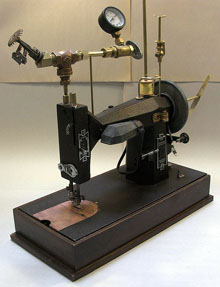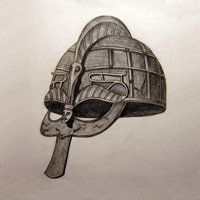 No, I don’t mean brand in the archaic sense of this word, which once could designate sword or torch :) Searching for all kinds of information about the Vikings, I constantly hit on various companies that have the same name. Indeed, the word Viking turned to be very attractive as a brand. People trust it and feel confident about products and services, which are associated with the Viking culture and values in their mind. Being very inquisitive by nature, I discovered a few interesting facts about some Viking brands, which I would like to share with you in this post.
No, I don’t mean brand in the archaic sense of this word, which once could designate sword or torch :) Searching for all kinds of information about the Vikings, I constantly hit on various companies that have the same name. Indeed, the word Viking turned to be very attractive as a brand. People trust it and feel confident about products and services, which are associated with the Viking culture and values in their mind. Being very inquisitive by nature, I discovered a few interesting facts about some Viking brands, which I would like to share with you in this post.
Husqvarna Viking is a Swedish company that was originally founded as a royal arms factory in 1689. However, in the early 1870s, the business struggled to fill orders for guns, and the board voted to manufacture sewing machines instead! [continue reading…]

This blog is on Vikings and for Vikings. Warriors and traders from Nordic countries reached as far as North America, leaving lasting marks of their presence everywhere. In battle, Vikings feared nothing, eager to join Odin in his hall. They knew that valkyries chose who would die and become one of the einherjar in Valhalla.
 The first armed conflict of Hengest and Horsa with Vortigern took place in 455. About the same time Horsa was killed in battle, while Hengest carried war on the Britons. By 473 he founded the first Anglo-Saxon kingdom, the kingdom of Kent. His successors were Esc, Octa and Eormenric of Kent (relationships in this line of kings and exact dates of their rule are not clear).
The first armed conflict of Hengest and Horsa with Vortigern took place in 455. About the same time Horsa was killed in battle, while Hengest carried war on the Britons. By 473 he founded the first Anglo-Saxon kingdom, the kingdom of Kent. His successors were Esc, Octa and Eormenric of Kent (relationships in this line of kings and exact dates of their rule are not clear).
The next stage of the conquest was led by the Saxon war-lord Ælle, who landed with his three sons on the Sussex shore in 477. In 491 he besieged and took the shore fort Anderida. Bede mentions Ælle as the king over all the provinces south of the river Humber. The Anglo-Saxon Chronicle lists Ælle as the first of the eight bretawaldas (a term that designated “rulers of Britain”), which may indicate that the king of the South Saxons was recognized as the ruler by other Anglo-Saxon leaders. [continue reading…]
 Incursions of Germanic warriors into Britain started late in the 4th century, during the Migration Period in Europe. Roman authors called them Saxons, but they certainly were divided into multiple ethnic groups. According to Bede the Venerable, armies of the invaders comprised representatives of the “three most powerful Germanic peoples” of the time: Angles, Saxons and Jutes. In the 6th century Procopius of Caesarea wrote that Britain was “inhabited by Angles, Frisians and Britons, each with their own king.” This testimony is supported by linguistics, since Old English and Old Frisian are closely related. Modern researchers believe that a wider range of Germanic peoples, including Franks, actually moved to Britain at the time. [continue reading…]
Incursions of Germanic warriors into Britain started late in the 4th century, during the Migration Period in Europe. Roman authors called them Saxons, but they certainly were divided into multiple ethnic groups. According to Bede the Venerable, armies of the invaders comprised representatives of the “three most powerful Germanic peoples” of the time: Angles, Saxons and Jutes. In the 6th century Procopius of Caesarea wrote that Britain was “inhabited by Angles, Frisians and Britons, each with their own king.” This testimony is supported by linguistics, since Old English and Old Frisian are closely related. Modern researchers believe that a wider range of Germanic peoples, including Franks, actually moved to Britain at the time. [continue reading…]

The power of Romans in Britain first weakened early in the 4th century. The main reason was economic crisis. Moreover, along the usual incursions of Scots and Picts, fierce attacks by Saxons, Attacotti, and Franks worsened the situation. Romano-British population was overwhelmed by the extraordinary conspiracy of the barbarians who acted in concert. In 367 a joint raid of Celts and Anglo-Saxons devastated the country, after the Roman garrison on Hadrian’s Wall rebelled and let Picts into Britannia. Nearly all Roman outposts and settlements fell into the hands of the invaders. Rome sent Theodosius the Elder, who was able to restore order.
However, in 383 a rebellion broke again. It was led by Magnus Maximus, who served under Theodosius. This Maximus has a lot in common with the main character of Gladiator, a 2000 historical epic by Ridley Scott. [continue reading…]

The Coppergate helmet (York helmet) was found in May 1982 at a site where many Viking Age artifacts had been discovered previously during the archeological excavations. The Anglo-Saxon helmet was right beneath the surface, protected by a brick chimney above. It was created about AD 750-775 but deposited considerably later: the brass decoration was already worn. There are also evidence of using the helmet in battle. Then someone buried it in a wood-lined pit along with a few other objects. It is unclear why such a fine possession was hidden, but it attracted universal attention after it was struck by the claw of a mechanical digger 28 years ago.
After careful excavation and reconstruction the quality craftsmanship of the Coppergate helmet became evident. It was made of iron, with two cheek-plates and a well-preserved mail curtain. [continue reading…]
Below is the list of Viking museums across the world. Do you know of any other Viking museums? Help expand the list! If you visited any of these, leave a review for us.
Dublinia & the Viking World (Dublin, Ireland)
A heritage centre, located in central Dublin, at the heart of the medieval city. The exhibitions at Dublinia explore life as it was in the medieval city and the world of the Vikings.
Jorvik Viking Centre (Great Britain)
A ‘must-see’ for visitors to the city of York and is one of the most popular visitor attractions in the UK outside London. [continue reading…]
